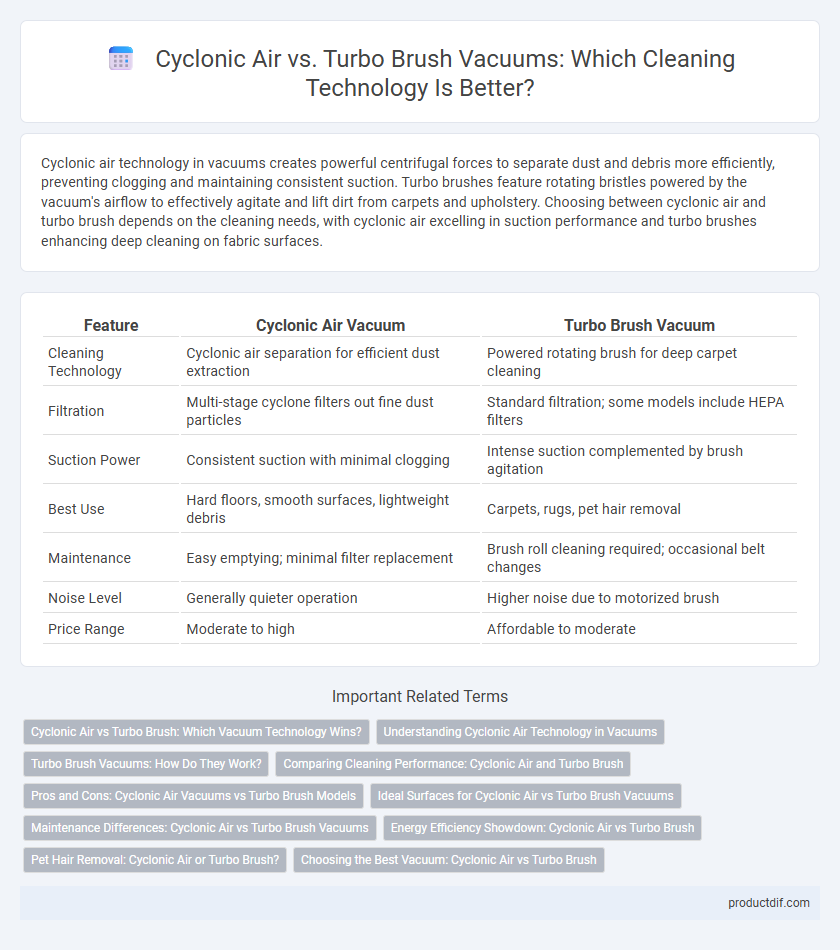Cyclonic air technology in vacuums creates powerful centrifugal forces to separate dust and debris more efficiently, preventing clogging and maintaining consistent suction. Turbo brushes feature rotating bristles powered by the vacuum's airflow to effectively agitate and lift dirt from carpets and upholstery. Choosing between cyclonic air and turbo brush depends on the cleaning needs, with cyclonic air excelling in suction performance and turbo brushes enhancing deep cleaning on fabric surfaces.
Table of Comparison
| Feature | Cyclonic Air Vacuum | Turbo Brush Vacuum |
|---|---|---|
| Cleaning Technology | Cyclonic air separation for efficient dust extraction | Powered rotating brush for deep carpet cleaning |
| Filtration | Multi-stage cyclone filters out fine dust particles | Standard filtration; some models include HEPA filters |
| Suction Power | Consistent suction with minimal clogging | Intense suction complemented by brush agitation |
| Best Use | Hard floors, smooth surfaces, lightweight debris | Carpets, rugs, pet hair removal |
| Maintenance | Easy emptying; minimal filter replacement | Brush roll cleaning required; occasional belt changes |
| Noise Level | Generally quieter operation | Higher noise due to motorized brush |
| Price Range | Moderate to high | Affordable to moderate |
Cyclonic Air vs Turbo Brush: Which Vacuum Technology Wins?
Cyclonic air technology excels in maintaining suction power by using centrifugal force to separate dust and debris from the air, preventing filter clogging and enhancing overall efficiency. Turbo brush attachments provide powerful agitation on carpets and upholstery, improving pet hair and deep dirt removal but can cause more maintenance due to brush wear and tangling. For sustained suction and low maintenance, cyclonic air vacuums generally outperform turbo brush models in long-term cleaning performance.
Understanding Cyclonic Air Technology in Vacuums
Cyclonic air technology in vacuums uses centrifugal force to separate dust and debris from the airflow, maintaining consistent suction power and preventing clogging. Unlike turbo brushes that rely on motorized rotating brushes to agitate dirt from carpets and upholstery, cyclonic systems efficiently capture fine particles and allergens without losing suction. This technology enhances vacuum performance by ensuring cleaner air output and longer filter life.
Turbo Brush Vacuums: How Do They Work?
Turbo brush vacuums use a rotating brush powered by the vacuum's airflow or a motor to agitate carpet fibers and loosen dirt, enhancing debris pickup on carpets and upholstery. Their design improves suction efficiency by lifting embedded dust and pet hair more effectively than standard vacuum heads. This mechanism makes turbo brush vacuums ideal for homes with pets or high-traffic areas requiring deep cleaning.
Comparing Cleaning Performance: Cyclonic Air and Turbo Brush
Cyclonic air technology generates powerful centrifugal force that efficiently separates dust and debris from the airflow, resulting in superior suction and prolonged filter life. Turbo brushes are equipped with rotating bristles designed to agitate and lift embedded dirt and pet hair from carpets and upholstery, enhancing cleaning effectiveness on textured surfaces. While cyclonic air excels in maintaining consistent suction power for fine dust, turbo brushes offer better performance on deep-seated debris and fibers.
Pros and Cons: Cyclonic Air Vacuums vs Turbo Brush Models
Cyclonic air vacuums excel at maintaining strong suction by separating dust and debris through centrifugal force, reducing filter clogging and ensuring consistent performance over time. Turbo brush models enhance cleaning efficiency on carpets and upholstery by using motorized rotating brushes that agitate and lift embedded dirt but may require more maintenance due to brush wear and hair tangling. Cyclonic air vacuums typically offer better filtration and less maintenance, while turbo brushes provide superior deep cleaning on textured surfaces yet can be noisier and less energy-efficient.
Ideal Surfaces for Cyclonic Air vs Turbo Brush Vacuums
Cyclonic air vacuums perform best on hard floors such as hardwood, tile, and laminate by efficiently separating dust through powerful air suction without losing suction power. Turbo brush vacuums excel on carpets and rugs, where rotating bristles actively lift dirt and pet hair embedded deep within fibers. Choosing between these technologies depends on the predominant floor type, with cyclonic air ideal for smooth surfaces and turbo brushes optimized for textured, high-pile flooring.
Maintenance Differences: Cyclonic Air vs Turbo Brush Vacuums
Cyclonic air vacuums require minimal maintenance due to their bagless design and self-cleaning cyclone system, which reduces filter clogging and airflow loss. Turbo brush vacuums need frequent brush roll cleaning to remove hair, threads, and debris that can impair performance and cause motor strain. Regular filter replacements and brush inspections are essential for turbo brush models to maintain optimal suction and prolong appliance lifespan.
Energy Efficiency Showdown: Cyclonic Air vs Turbo Brush
Cyclonic air vacuum technology uses centrifugal force to separate dust and debris, maintaining consistent suction power without clogging filters, resulting in superior energy efficiency. Turbo brush vacuums rely on rotating brush heads that can consume more power but are highly effective on carpets by agitating dirt and pet hair. Energy consumption metrics reveal cyclonic air vacuums typically use 10-20% less electricity than turbo brush models, making them a cost-effective choice for long-term cleaning.
Pet Hair Removal: Cyclonic Air or Turbo Brush?
Cyclonic air technology excels in pet hair removal by maintaining strong, consistent suction that efficiently lifts hair from carpets and upholstery without tangling. Turbo brushes enhance pet hair pickup through motorized rotating bristles that agitate fibers, making it easier to extract embedded fur. For households with pets, combining cyclonic suction with a turbo brush attachment offers optimal cleaning performance.
Choosing the Best Vacuum: Cyclonic Air vs Turbo Brush
Cyclonic air technology in vacuums uses centrifugal force to separate dust and debris, maintaining strong suction power and preventing clogging. Turbo brush attachments enhance cleaning by using a motorized rotating brush to lift dirt and pet hair from carpets and upholstery more effectively. Selecting the best vacuum depends on your cleaning needs: cyclonic air models excel in suction longevity and low maintenance, while turbo brushes offer superior performance on textured surfaces and for pet owners.
Cyclonic air vs Turbo brush (vacuum) Infographic

 productdif.com
productdif.com